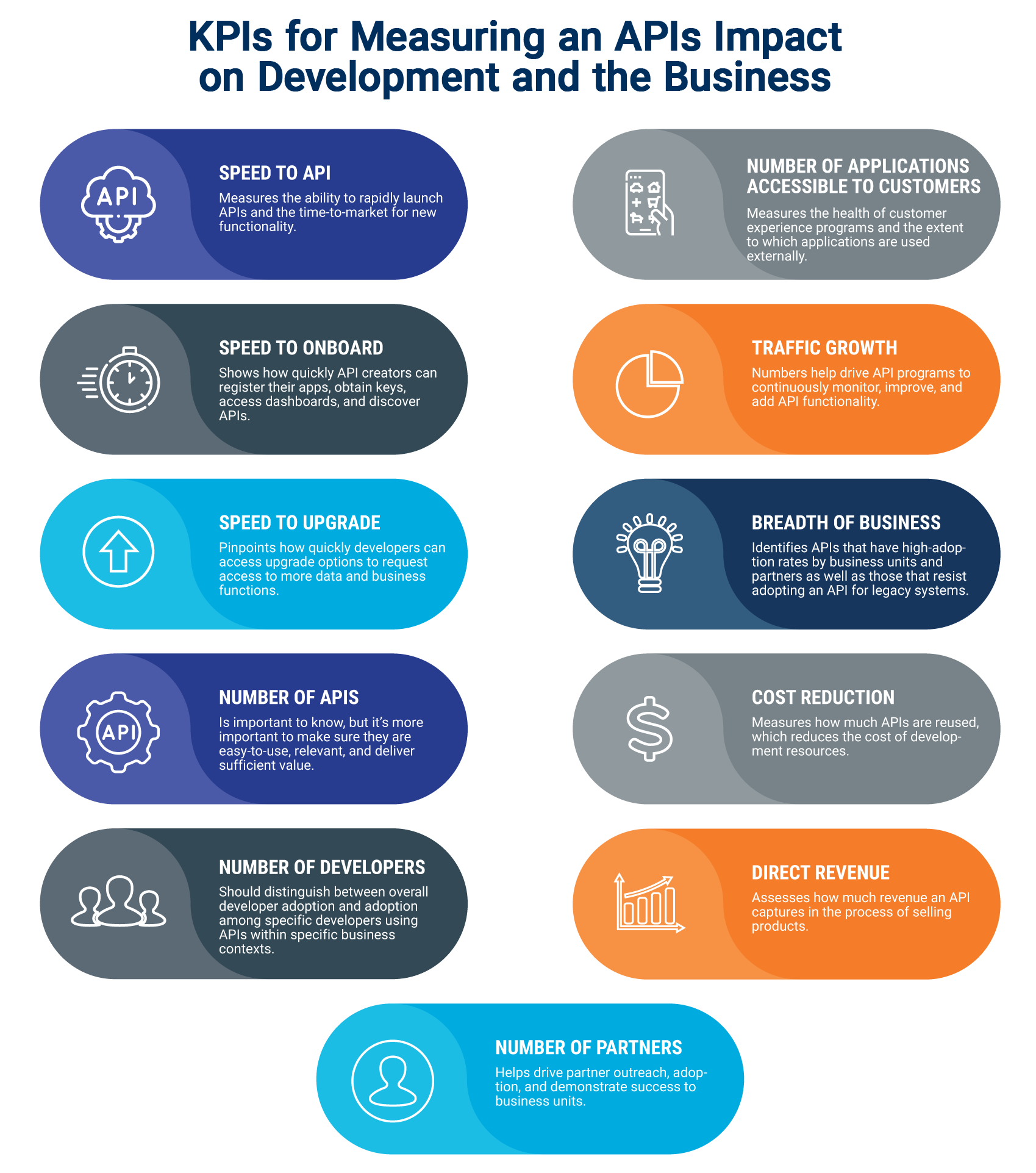
KPIs to Measure the Value of Your APIs
Why Is It Important to Set and Monitor KPIs for Your APIs?
With the key role Application Programming Interfaces (APIs) play in daily business operations, API Key Performance Indicators (KPIs) are now deeply interwoven with today’s business strategies. The more closely you measure your API KPIs, the more likely you are to effectively manage them for performance improvements.
Setting and monitoring KPIs provides a consistent frame of reference for the performance of your APIs that’s accessible to IT executives, developers, and program managers. The key is to select KPIs that closely reflect your business strategy. This gives stakeholders from all three groups the ability to see how APIs perform in the areas that are most meaningful to their roles and responsibilities.
Different Roles Value Different KPIs for APIs
The API KPIs to set and monitor are usually determined by a product manager, who will report API performance to stakeholders ranging from IT executives to developers. The stakeholders may be internal or external to the company depending on whether an API is private or for public use.
The roles within every company vary, but here are the general KPIs that each audience is interested in:
- IT executives typically evaluate APIs for their ability to bring speed and quality to the digital experiences delivered to end-users and customers. Executives may also be interested in an API’s ability to grow new business opportunities or reduce operational costs. In some cases, executives are concerned with KPIs that measure the feasibility of converting internal APIs into a white-labeled product for external partners to resell.
- As developers are more technical and work directly with APIs, the KPIs they tend to look at pertain to API performance, including latency and error rates. Developers also want to know how many other developers are using an API, the throttling limit, the length of time to complete a query, and how many endpoints an API can service at one time.
- Program Managers are another audience interested in API KPIs. They are usually in charge of enabling digital business and bringing the customer journey to life, so they want to know which APIs are seeing the most use by customers. They also want to know if APIs contribute positively to helping end-users and customers complete their journeys, as well as the time-to-market for new API capabilities.
KPIs for Measuring API Performance
Latency KPIs are perhaps the most important metric developers will examine. The location of APIs can impact the overall latency and total API call times, so it’s vital to measure the times for completing TCP connections, DNS look-ups, server-side processing, and Internet travel.
In addition to latency, developers tend to focus most on these three KPI metrics:
- Measured pass rate tallies the actual measured success rate for an API call from a specific location.
- Effective pass rate identifies events and performance issues that cause timeouts, latencies, and other problems that affect end-users.
- Effective error rate determines the percentage of API calls that fail, which is often caused by code failures and slow responses.
Another performance KPI to consider is CASC (Cloud API Service Consistency). This KPI measures the performance of your cloud infrastructure provider in provisioning API services. If your APIs are deployed in a hosted data center, that means you’ll need to work with an external product development partner to measure this particular KPI.
KPIs for Measuring API Impact on Development and the Business
Executives and IT managers tend to look at a whole different set of KPIs. Here are the most common:
- Speed to API measures the ability to rapidly launch APIs and the time-to-market for new functionality.
- Speed to onboard shows how quickly API creators can register their apps, obtain keys, access dashboards, and discover APIs.
- Speed to upgrade pinpoints how quickly developers can access upgrade options to request access to more data and business functions.
- Number of APIs is important to know, but it’s more important to make sure they are easy-to-use, relevant, and deliver sufficient value.
- Number of developers should distinguish between overall developer adoption and adoption among specific developers using APIs within specific business contexts.
- Number of partners helps drive partner outreach, adoption, and demonstrate success to business units.
- Number of applications accessible to customers measures the health of customer experience programs and the extent to which applications are used externally.
- Traffic growth numbers help drive API programs to continuously monitor, improve, and add API functionality.
- Breadth of business identifies APIs that have high-adoption rates by business units and partners as well as those that resist adopting an API for legacy systems.
- Cost reduction measures how frequently APIs are reused, which reduces the cost of development resources.
- Direct revenue assesses how much revenue an API captures in the process of selling products.
The Net Promoter Score (NPS) is another KPI to keep an eye on. It monitors developers adopting and calling APIs from within their apps. And if you are searching an API Marketplace, many of them have API reviews, which you can check to see what the average user review is. For APIs that expose data, metrics pertaining to data volume and transfer might be available as well.
Putting Your APIs to Work
With all of these KPIs to choose from, it’s important to determine which ones to utilize for your API environment. The KPIs you select should align with how the APIs add value to your business. It’s also best to not put too much stock in the number of APIs or the number of API calls, which may look impressive but don’t always correlate to business value.
While developers will likely focus on latency, pass rates, and error rates, IT executives and program managers will turn to the higher-level KPIs. If your APIs are meant to drive revenue, focus on API revenue. If you want to grow awareness, then the number of developers, customers, and partners will be important KPIs to monitor. And if your APIs should reduce costs, look at the money you save by not using third-party APIs or not having to recreate functionality with internal resources.
To get the most of your KPIs, auto-generate and check them on a recurring basis—daily, weekly, or monthly, depending on the volume of activity each API generates. Also, set goals for what you want your APIs to achieve. By simply checking the KPIs and measuring their performance over time, you will have the data you need to drive decisions regarding what improvements need to be made to your entire API ecosystem.
[adinserter name=”API-Closing”]
[adinserter name=”API-ebook-offer”]
Recent blog posts

Stay in Touch
Keep your competitive edge – subscribe to our newsletter for updates on emerging software engineering, data and AI, and cloud technology trends.




